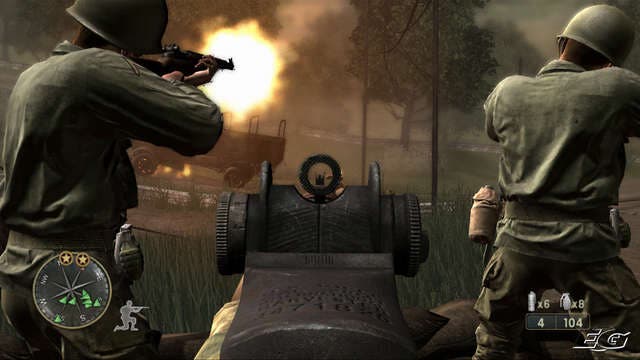Call of Duty 3
Pack up your troubles.
Just when you thought that interest in World War II games was on the wane, along comes Call of Duty 2 and becomes by far the biggest selling Xbox 360 launch title.
Clearly the public's lust for shooting thousands of Nazi soldiers is as high as ever - especially when it's framed in the cinematically intense fashion that has become Infinity Ward's trademark. Activision knew it had to get a high quality follow-up on the shelves in time for this Christmas' buying frenzy - especially with EA's latest Medal of Honor franchise making its comeback in 2007. Having the whole WWII market to itself for the second Christmas running is a gift-wrapped opportunity.
But Infinity Ward isn't one of those sweatshop developers that can just merrily churn out annual updates of its games - and Activision knows it. Which is precisely why it's been such a smart decision to have another talented developer beavering away on various Call of Duty console projects over the past few years. And with IW taking its traditional two-year cycle to work on a proper 'next-gen' Call of Duty game (presumably due out next Christmas), Call of Duty 3 sees Treyarch take centre stage for the first time
Act of neglect
But its first controversial act has been to neglect to do a PC version, which, given the series originated on the beige box, has annoyed a significant chunk of its audience. Conspiracy theorists have every right to suspect that hardcore fans who've traditionally played the game on PC are effectively being funnelled into buying a next-gen console version. Certainly, here in Europe that decision puts an awful lot of extra focus on the Xbox 360 version, where the PS3 version is an irrelevance until March. By accident or design, it's handed Microsoft another golden opportunity to shift a few more consoles to those who won't be denied their latest CoD fix.

It's disappointing, then, to find that Call of Duty 3's core single-player offering feels like it's been rushed to market to fulfil demand rather than its potential. If it's not the minor technical glitches that give the impression of slapdash development, it's the half-baked new ideas, resistance to change and cut and paste mission design that serve as a stark reminder that we've been here so many, many times before that novelty hasn't just worn off, it's completely transparent. Luckily the multiplayer is a major saving grace, but we'll come back to that one.
Given that so many of the famous events of World War II have been covered off, Call of Duty 3 thumbs the pages of the history books to focus on one specific sequence of inter-connected events in the summer of 1944 that involved not only the Brits and the Yanks, but the Poles and Canadians as well, all fighting to squeeze the Falaise gap and liberate the French. Unlike Treyarch's more focused campaign in last year's acclaimed 'last-gen' Call of Duty 2: Big Red One, this reverts back to the formula where you're flitting between different nations over the course of the rather brief 14-mission campaign. As a result, the game often feels like a disconnected series of set-pieces culled from any WWII title you might care to mention. The narrative tries its best to inject character into the proceedings with some cheap anti-French gags and the odd flare-up between soldiers, but it mostly falls flat, and what you're left with is a game that never truly drags you in. Your sense of purpose is reduced to eyeing the mini-map and heading for the next starred objective. Destroy the artillery. Defend the south side. Clear out that house. Regroup with your squad. And all this surrounded by an anonymous sea of re-generating allied cannon fodder to make the scenes look as epic as possible.
Just an illusion

At first glance, you could easily argue the case for Call of Duty 3 being one of the best-looking games ever. Some of the scenes of intense battle are right up there with the most incredible sequences you've ever seen committed to videogaming, and it's no wonder they made for incredible-looking teaser videos. Appropriately enough, some of the very best are right at the beginning of the game - always a key tactic to pull in the unwary punter. The individual blades of grass swaying in the breeze, that church roof exploding in a massive plume of dust and debris. That tank rolling on by, inches from your head as you scramble through a stream. The incredible rattle of gunfire and explosions from all sides. Man, the explosions. The dust. The smoke. The sound is incredible too, with shouts of desperation from pinned down comrades alerting you to the machine gun nest that's got them pressed up against a tombstone, rather fittingly. With a spectacular Joel Goldsmith score putting the gloss on the package, it merely underlines that it's still capable of being the same incredible assault on the sense that it ever was - but if you stop and look around for more than a few seconds, you're constantly reminded that the battle doesn't ever just carry on around you. That's the illusion. The reality is all-too easy to identify, and it generally relies on you moving the scripted events on and going in the direction the game dictates. Despite some very loose concessions to in-mission freedom (read: branching paths or choice over which house to clear first), you're still tightly penned in by some ludicrous invisible walls and rarely given a chance to experiment. Of course, it's always been this way, but in essence Call of Duty 3 is weighed down by the baggage of old school game design decision that we really should have moved on from by now.








